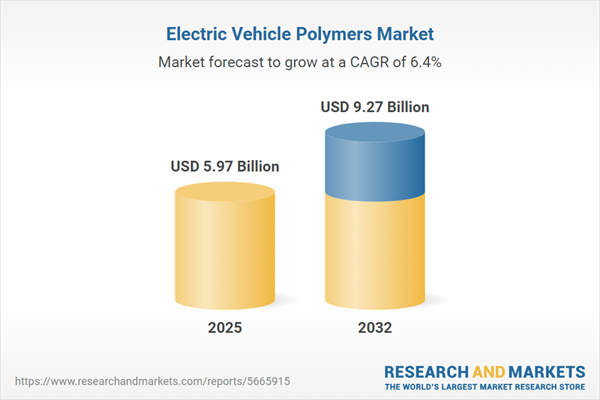Speak directly to the analyst to clarify any post sales queries you may have.
The electric vehicle polymers market is undergoing rapid transformation, driven by the surge in vehicle electrification, evolving regulatory standards, and a strong industry focus on sustainability and supply chain resilience.
Market Snapshot: Electric Vehicle Polymers Market
The Electric Vehicle Polymers Market grew from USD 5.63 billion in 2024 to USD 5.97 billion in 2025. It is projected to continue its upward trajectory at a CAGR of 6.40%, reaching USD 9.27 billion by 2032. This market reflects the expanding role of high-performance polymers in electric mobility as manufacturers and suppliers respond to increasingly stringent global emissions targets and the push for more efficient, safer vehicles. Investments in lightweight materials, enhanced thermal management, and tailored polymer solutions for EVs are setting the pace for industry innovation.
Scope & Segmentation
- Material Types: Elastomers (acrylate, silicone, styrene-butadiene rubber); Thermoplastics (acrylonitrile butadiene styrene, polypropylene, polyvinyl chloride); Thermosets (epoxy, phenolic resins, polyurethane).
- Application Areas: Exterior components (body panels, bumpers, trunk lids); Interior components (dashboard, headliners, seating); Powertrain systems (battery housings, cooling pipes, transmission systems).
- Vehicle Categories: Commercial vehicles (heavy and light); Passenger vehicles.
- Distribution Channels: Offline and online sales of OEM and aftermarket components.
- End-Use Segments: OEMs and aftermarket suppliers.
- Regions Covered: Americas (North America, Latin America), Europe, Middle East & Africa (Europe, Middle East, Africa), Asia-Pacific (China, India, Japan, Australia, South Korea, Indonesia, Thailand, Malaysia, Singapore, Taiwan).
- Leading Companies Profiled: 3M Company, Addiplast SA, Aearo Technologies, AlphaGary Corporation, Arkema S.A., Arlanxeo, Asahi Kasei Corporation, Ascend Performance Materials Holdings, BASF SE, Celanese Corporation, Chi Mei Corporation, Covestro AG, Croda International PLC, Daikin Industries Ltd., DIC Corporation, DuPont de Nemours, Evonik Industries AG, JSR Corporation, LG Chem Ltd., LyondellBasell Industries Holdings, Mitsubishi Chemical Corporation, Saudi Basic Industries Corporation, Solvay S.A., Sumitomo Chemical, Teijin Limited, The Dow Chemical Company, Toray Industries.
Key Takeaways for Senior Decision-Makers
- Advanced polymer solutions are central to next-generation electric vehicle engineering, offering essential benefits in weight reduction, thermal management, and durability.
- Collaboration between automakers and polymer suppliers is accelerating innovation cycles, with emphasis on qualifying new materials to meet evolving safety and performance specifications.
- Growth in digital design and additive manufacturing is optimizing component development, enabling smarter, more efficient manufacturing workflows across the supply chain.
- Efforts in sustainable materials, including bio-based polymers and recycling initiatives, are gaining traction in line with regulatory initiatives and ESG commitments.
- OEMs and suppliers are taking proactive measures to mitigate potential downstream disruptions by building robust sourcing and material qualification strategies.
Tariff Impact: Preparing for Cost Shifts and Supply Chain Adjustments
The planned introduction of tariffs on imported polymers in the United States from 2025 is expected to influence sourcing decisions and procurement strategies across the electric vehicle supply chain. Companies are reevaluating supplier footprints, prioritizing domestic production, and adopting hedging tactics to maintain margin stability. These adjustments highlight the growing relevance of flexible, resilient supply chain models within the electric vehicle polymers ecosystem.
Methodology & Data Sources
This analysis combines structured primary interviews with material scientists, OEM engineers, and industry experts, alongside secondary research from market reports, patents, regulatory documents, and company presentations. Triangulation and peer review ensure the highest degree of reliability and analytical rigor.
Why This Report Matters
- Provides a granular view of the electric vehicle polymers market, segmented by material, application, vehicle type, channel, and region.
- Enables leadership teams to navigate technology shifts and global trade risks with clear, actionable intelligence.
- Supports strategic planning by highlighting collaboration opportunities, supplier selection criteria, and sustainable procurement priorities.
Conclusion
The electric vehicle polymers sector is defined by dynamic innovation, technology partnerships, and evolving regulatory requirements. Companies equipped with deep market insight and agile strategies will be positioned for sustained success as the EV ecosystem continues to evolve.
Additional Product Information:
- Purchase of this report includes 1 year online access with quarterly updates.
- This report can be updated on request. Please contact our Customer Experience team using the Ask a Question widget on our website.
Table of Contents
3. Executive Summary
4. Market Overview
7. Cumulative Impact of Artificial Intelligence 2025
Companies Mentioned
The companies profiled in this Electric Vehicle Polymers market report include:- 3M Company
- Addiplast SA
- Aearo Technologies
- AlphaGary Corporation
- Arkema S.A.
- Arlanxeo
- Asahi Kasei Corporation
- Ascend Performance Materials Holdings Inc.
- BASF SE
- Celanese Corporation
- Chi Mei Corporation
- Covestro AG
- Croda International PLC
- Daikin Industries Ltd.
- DIC Corporation
- DuPont de Nemours, Inc
- Evonik Industries AG
- JSR Corporation
- LG Chem Ltd.
- LyondellBasell Industries Holdings
- Mitsubishi Chemical Corporation
- Saudi Basic Industries Corporation
- Solvay S.A.
- Sumitomo Chemical Co., Ltd.
- Teijin Limited
- The Dow Chemical Company
- Toray Industries, Inc.
Table Information
| Report Attribute | Details |
|---|---|
| No. of Pages | 197 |
| Published | November 2025 |
| Forecast Period | 2025 - 2032 |
| Estimated Market Value ( USD | $ 5.97 Billion |
| Forecasted Market Value ( USD | $ 9.27 Billion |
| Compound Annual Growth Rate | 6.4% |
| Regions Covered | Global |
| No. of Companies Mentioned | 28 |









